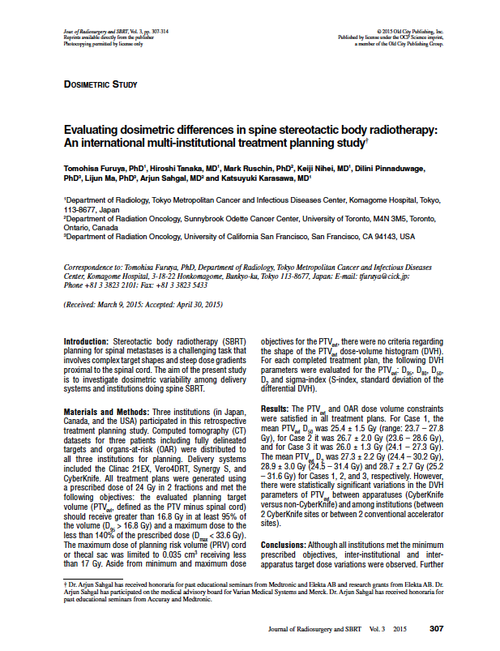- Home
- Journal Contents Downloads
- JRSBRT Downloads
- JRSBRT 3.4, p. 307-314
Product Description
Evaluating dosimetric differences in spine stereotactic body radiotherapy: An international multi-institutional treatment planning study
Tomohisa Furuya, Hiroshi Tanaka, Mark Ruschin, Keiji Nihei, Dilini Pinnaduwage, Lijun Ma, Arjun Sahgal, and Katsuyuki Karasawa
Introduction: Stereotactic body radiotherapy (SBRT) planning for spinal metastases is a challenging task that involves complex target shapes and steep dose gradients proximal to the spinal cord. The aim of the present study is to investigate dosimetric variability among delivery systems and institutions doing spine SBRT.
Materials and Methods: Three institutions (in Japan, Canada, and the USA) participated in this retrospective treatment planning study. Computed tomography (CT) datasets for three patients including fully delineated targets and organs-at-risk (OAR) were distributed to all three institutions for planning. Delivery systems included the Clinac 21EX, Vero4DRT, Synergy S, and CyberKnife. All treatment plans were generated using a prescribed dose of 24 Gy in 2 fractions and met the following objectives: the evaluated planning target volume (PTVevl, defined as the PTV minus spinal cord) should receive greater than 16.8 Gy in at least 95% of the volume (D95 > 16.8 Gy) and a maximum dose to the less than 140% of the prescribed dose (Dmax < 33.6 Gy). The maximum dose of planning risk volume (PRV) cord or thecal sac was limited to 0.035 cm3 receiving less than 17 Gy. Aside from minimum and maximum dose objectives for the PTVevl, there were no criteria regarding the shape of the PTVevl dose-volume histogram (DVH). For each completed treatment plan, the following DVH parameters were evaluated for the PTVevl: D95, D80, D50, D2 and sigma-index (S-index, standard deviation of the differential DVH).
Results: The PTVevl and OAR dose volume constraints were satisfied in all treatment plans. For Case 1, the mean PTVevl D50 was 25.4 ± 1.5 Gy (range: 23.7 – 27.8 Gy), for Case 2 it was 26.7 ± 2.0 Gy (23.6 – 28.6 Gy), and for Case 3 it was 26.0 ± 1.3 Gy (24.1 – 27.3 Gy). The mean PTVevl D2 was 27.3 ± 2.2 Gy (24.4 – 30.2 Gy), 28.9 ± 3.0 Gy (24.5 – 31.4 Gy) and 28.7 ± 2.7 Gy (25.2 – 31.6 Gy) for Cases 1, 2, and 3, respectively. However, there were statistically significant variations in the DVH parameters of PTVevl between apparatuses (CyberKnife versus non-CyberKnife) and among institutions (between 2 CyberKnife sites or between 2 conventional accelerator sites).
Conclusions: Although all institutions met the minimum prescribed objectives, inter-institutional and inter-apparatus target dose variations were observed. Further study is necessary to determine target dose constraints that may minimize inter-institutional variations and lead to plan standardization.
Keywords: Spine metastases, spine stereotactic body radiotherapy, dosimetric difference, target prescribed dose, apparatus dependence, international multi-institutional planning study
After payment has been processed for your order of a digital copy (PDF) of this article, you will see a download link on your completed order page and also receive an email containing a download link. The links, which will enable you to download one copy of the article, will expire after 24 hours.
 Loading... Please wait...
Loading... Please wait...



